Why Pomegranate Blooms Fall: What To Do For Dropping Flowers On Pomegranate
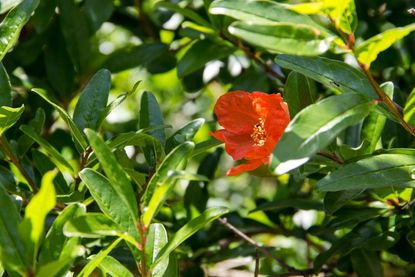
When I was a kid, I would often find a pomegranate in the toe of my Christmas stocking. Whether put there by Santa or Mom, pomegranates represented the exotic and rare, eaten just once a year. Punica granatum, the pomegranate, is a tree that is native to Iran and India, hence thriving in hot, dry conditions akin to those found in the Mediterranean. While pomegranate trees are drought tolerant, they do need good, deep irrigation periodically-- similar to the requirements for citrus trees. Not only is the plant grown for its delicious fruit (actually a berry), but it is cultivated for the stunning bright red flowers on pomegranate trees. Pomegranates can be a bit pricey, so if you live in a climate that will support growing your own, you have a win/win savvy garden specimen. Although the tree is fairly resilient, it's susceptible to several issues and one of them is pomegranate flower drop. If you are lucky enough to own a pomegranate tree, you may be wondering why pomegranate blooms fall and how to prevent bud drop on pomegranate.
Why Pomegranate Blooms Fall?
There are a number of reasons for pomegranate flower drop. Pollination: To answer the question of why pomegranate flowers fall off, we need to know a little about the plant's reproduction. Pomegranate trees are self-fruitful, which means the flowers on the pomegranate are both male and female. Pollinating insects and hummingbirds assist in spreading the pollen from flower to flower. You can even help too by using a small brush and lightly brushing from bloom to bloom. Male pomegranate flowers fall off naturally as do un-fertilized female blooms, while fertilized female flowers remain to become fruit. Pests: Pomegranate trees begin to flower in May and continue through early autumn. If your pomegranate flowers fall off in early spring, the culprit may be insect infestation such as whitefly, scale, or mealybugs. Inspect the tree for damage and consult your local nursery for a recommendation regarding the use of insecticide. Disease: Another possible reason for pomegranate flower drop may be due to a fungal disease or root rot. An anti-fungal spray should be applied and again, the local nursery can help with this. Environmental: The tree may drop flowers due to cold temperatures as well, so it is a good idea to protect or move the tree if a chill is in the forecast. Finally, although the tree is drought resistant, it still needs a good deep watering if you want it to produce fruit. Too little water will cause the blossoms to drop from the tree. Pomegranate trees need to be mature to produce fruit, three to five years or so. Prior to this, as long as the tree is watered, fertilized, pollinated properly, and free of pests and disease, a little pomegranate flower drop is perfectly natural and no cause for alarm. Just be patient and eventually you, too, can be enjoying the delicious ruby red fruit of your very own exotic pomegranate.
Gardening tips, videos, info and more delivered right to your inbox!
Sign up for the Gardening Know How newsletter today and receive a free download of our DIY eBook "Bring Your Garden Indoors: 13 DIY Projects For Fall And Winter".

Amy Grant has been gardening for 30 years and writing for 15. A professional chef and caterer, Amy's area of expertise is culinary gardening.
-
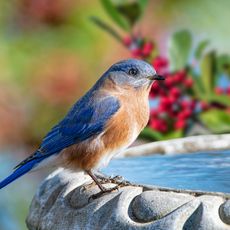 Gifts For Bird Lovers, Birders and Birdies To Attract More Feathered Friends To Your Yard!
Gifts For Bird Lovers, Birders and Birdies To Attract More Feathered Friends To Your Yard!If you’re looking to bring more birdies to your garden, these gifts for bird lovers should definitely be on your wish list. Grab some avian attractions to get your gardens all aflutter
By Janey Goulding
-
 Elegant Exotics: 8 Beautiful Amaryllis Varieties That Will Brighten Any Holiday Display
Elegant Exotics: 8 Beautiful Amaryllis Varieties That Will Brighten Any Holiday DisplayWhether red, pink, white or variegated, the right amaryllis varieties can enhance any living space, especially during the holidays. We round up eight of the most exquisite
By Bonnie L. Grant
-
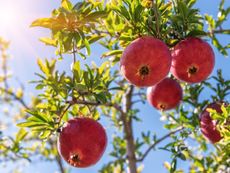 Replanting Container Grown Pomegranate – Tips On Transplanting Potted Pomegranates Outside
Replanting Container Grown Pomegranate – Tips On Transplanting Potted Pomegranates OutsideIt’s pretty easy to transplant a potted pomegranate outdoors. Click for more information on moving a potted pomegranate.
By Teo Spengler
-
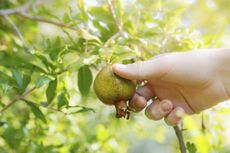 Picking Pomegranates – Learn About Harvesting Pomegranate Fruit
Picking Pomegranates – Learn About Harvesting Pomegranate FruitPomegranates have become so popular that many people in USDA zones 7-10 are trying their hand at growing and picking their own pomegranates. So how and when do you harvest pomegranates? Click this article to learn more.
By Amy Grant
-
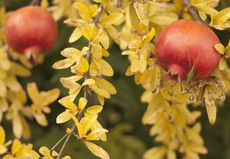 Yellowing Leaves On Pomegranate: Why Pomegranate Leaves Turn Yellow
Yellowing Leaves On Pomegranate: Why Pomegranate Leaves Turn YellowGrowing a pomegranate tree can be a rewarding experience filled with delicious fruits and beautiful juice, but growing these fruit trees isn't all paradise. If your plant is looking a little off, with yellowing leaves, click here to learn how to save it.
By Kristi Waterworth
-
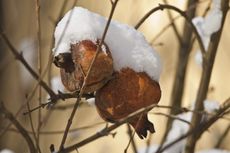 Pomegranate Winter Care: How To Care For Pomegranate Trees In Winter
Pomegranate Winter Care: How To Care For Pomegranate Trees In WinterPomegranates hail from the far eastern Mediterranean so as you may expect they appreciate plenty of sun and should be protected in the winter time. How do you go about overwintering pomegranate trees? Find out in this article.
By Amy Grant
-
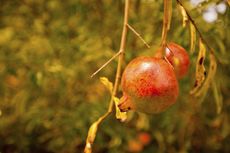 Pomegranate Tree Leaves Falling Off: Why Do Pomegranate Trees Lose Leaves
Pomegranate Tree Leaves Falling Off: Why Do Pomegranate Trees Lose LeavesPomegranates are typically grown for their fleshy, sweet-tart edible fruits. That being said, pomegranate leaf loss can be a frustrating problem for many gardeners. Click on the article that follows to learn why this happens.
By Karen Boness
-
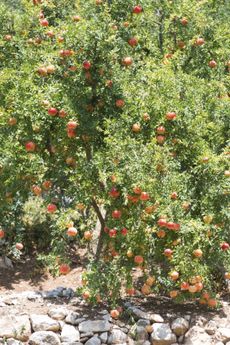 Pomegranate Tree Pruning – Learn About The Cutting Of Pomegranates
Pomegranate Tree Pruning – Learn About The Cutting Of PomegranatesIt is important to prune pomegranate trees properly if you want to increase fruit production and maintain an attractive form. Unfortunately, these two goals are in conflict. Learn more about pruning pomegranates in this article.
By Karen Boness
-
 Propagating Pomegranate Trees: How To Root A Pomegranate Tree
Propagating Pomegranate Trees: How To Root A Pomegranate TreeGrowing a pomegranate tree from cuttings is cost-free and relatively easy. Find more information about how to root a pomegranate tree from pomegranate tree cuttings in the article that follows. Click here to learn about pomegranate propagation.
By Teo Spengler
-
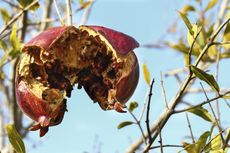 Problems Of Pomegranates: Learn About Diseases In Pomegranate
Problems Of Pomegranates: Learn About Diseases In PomegranatePomegranate fungal diseases are a common issue in plants grown in wet regions. Other diseases in pomegranate are rarer and not permanently damaging to the tree. Learn the problems of pomegranates in this article. Click here for more info.
By Jackie Carroll